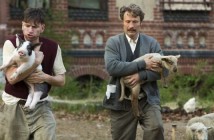
Editor’s Note: This month marks the 35th anniversary of Raging Bull. Feel free to share your memories of this film in the comments section below.
Raging Bull, Martin Scorsese’s greatest film, shows that an audience can hate a character almost from the word go and still be compelled by their story enough to keep watching to the end of the film and then watch the film again and again. The fact that it still stands as one of the greatest films of all time, and the best film of the 1980s and audiences still come back to it 35 years later is remarkable. It’s a true testament to Scorsese and actor Robert De Niro, whose total commitment to the character of boxer Jake La Motta is just as impressive today as it was then.
The story tracks La Motta as a contender for the middleweight championship in 1941 all the way through retirement and disgrace in the late 1950s and early 1960s. Scorsese builds a curious model of enabling us to root for La Motta in the ring and despise him outside of it. Working from a screenplay by Paul Schrader (who wrote Taxi Driver for Scorsese) and Mardik Martin (who also worked on Scorsese screenplays for Mean Streets and New York, New York as well as Scorsese documentaries Italianamerican and The Last Waltz) that Scorsese and De Niro also did uncredited work on, Scorsese balanced out the empathy with the revulsion. In some of the first scenes, we see La Motta battling it out in the ring and you cheer for his win, only to see him sitting home and verbally abusing his wife then terrorizing her by flipping the table over, all because he decided his steak was overcooked (without eating any of it to know).
 From there, La Motta and his brother Joey (Joe Pesci) are at the local pool where Jake spies Vicky (Cathy Moriarty), a 15-year-old blond beauty who captures his attention and obsession. He starts taking her out and eventually his wife leaves him and he’s free to pursue Vicky, and they start going together by 1943 (when she is still only 17) and are married in 1945. All the while, Jake is trying to fight his way to the title match, getting stuck fighting Sugar Ray Robinson (Johnny Barnes) over and over because no one else will fight either of them. As this is going on, Jake has become obsessive over Vicky, presuming that everyone is trying to sleep with her and even going so far as to assume that she has slept with every man she touches, even if it’s a casual hello. His obsession goes so far that he even accuses Joey of sleeping with her and when Vicky lies and says she has slept with all these men, he beats his brother savagely, causing a rift between the two that lasted for many years.
From there, La Motta and his brother Joey (Joe Pesci) are at the local pool where Jake spies Vicky (Cathy Moriarty), a 15-year-old blond beauty who captures his attention and obsession. He starts taking her out and eventually his wife leaves him and he’s free to pursue Vicky, and they start going together by 1943 (when she is still only 17) and are married in 1945. All the while, Jake is trying to fight his way to the title match, getting stuck fighting Sugar Ray Robinson (Johnny Barnes) over and over because no one else will fight either of them. As this is going on, Jake has become obsessive over Vicky, presuming that everyone is trying to sleep with her and even going so far as to assume that she has slept with every man she touches, even if it’s a casual hello. His obsession goes so far that he even accuses Joey of sleeping with her and when Vicky lies and says she has slept with all these men, he beats his brother savagely, causing a rift between the two that lasted for many years.
Aiding Scorsese’s superlative direction (which will be discussed later) is De Niro’s flawless performance. He plays La Motta like an oaf who only knows fighting, inside and outside the ring. His answer is always violence and it is all he understands. The only things he thinks about are fighting, his weight so he can fight and his paranoid delusions that his wife is sleeping around. De Niro went that extra mile for authenticity by getting into top shape for the scenes from La Motta’s youth and his fighting prime and then requested a hiatus so he could put on the weight required to look the part of La Motta in his decline. Adding somewhere around 50 pounds, he went from peak condition to health hazard in a matter of months to avoid prosthetics and keep the part as real as possible. He wore a prosthetic nose, so he didn’t go so far as to have his nose repeatedly broken but it’s possible that it crossed his mind. He gives one of the most impressive immersive performances ever committed to film here and proves once again that he is one of the best actors to work in the medium. Through De Niro, we understand La Motta to be primal and animalistic to an extreme, with few if any redeeming qualities, yet in some (very) small way, he can still be empathized with. Certainly not in his wife beating, or his beating of anyone else, but in the way that he just cannot understand having something good for himself. He is constantly bothered by how attractive his wife is and how he perceives other men’s attention to her, so much so that he cannot even enjoy that she chose him and continued to stay with him as long as she does because she loves him despite his obsession. De Niro gives La Motta such low self-worth that he’ll go so far as destroying another boxer’s face just because Vicky said he was good looking. It’s this self-worth issue that De Niro hits on early and keeps hitting throughout the film, driving home the fact that he thinks so little of himself that others can’t possibly think anything better of him, so why wouldn’t his attractive wife cheat on him? De Niro also utilizes La Motta’s over-riding sense of fight or flight to great effect. It seems that is the only sensation La Motta has, so he just pounds away at anyone he feels threatened by. He’s sent into a tailspin when he starts to encounter situations he can’t punch his way out of and he just can’t figure out how to get out of his situation without his fists. If he weren’t such a repugnant person, you’d almost feel sorry for him.
And then there was Scorsese. His choices in direction for this film were perfect. From his decision to shoot in black and white, with his Taxi Driver cinematographer Michael Chapman, to staying inside the ring during the boxing matches, he never makes a false move behind the camera. By choosing to be inside the ring for the fights, he had to alter the size of the ring, to allow for the camera. This has a brilliant effect of warping the reality of the ring, making the combatants look like they’ve entered another world when they are inside the ring. It also gives us first-hand feelings of how it may feel to be the one hitting or being hit, since the sequences are so visceral, you feel like you’re a fighter. He also uses fast and slow motion during the fights to further warp time and give a sense of what it must feel like to be there, anticipating each move the other guy is going to make. You’re in it with Jake, for good or ill.
His other techniques, outside the ring, are just as perfect. Instead of employing a montage of fights to show the passage of time at one point, Scorsese uses subtitles telling the year and the fight over still frames of the fights, while treating us to home footage style accounts of Jake and Vicky’s home life. The static shots of the fights and the moving images of family show that his fights were routine and not worth showing, but his private life was where his real action was during which he got married and had two kids with Vicky, and Joey got married and had a kid or two as well. By taking the focus off of the fights but still incorporating them, Scorsese gives us the perfect representation of how life was for Jake at the time without ever needing a spoken word.
A fair amount of credit also has to go to editor Thelma Schoonmaker. This was her first screen credit since she was lead editor on Woodstock in 1970. This wasn’t by design, Schoonmaker wanted to work as an editor but was barred admittance to the editing guild until Scorsese got her in. Since this film, Schoonmaker (who is the widow of the great British filmmaker Michael Powell, whom Scorsese introduced her to) has worked exclusively with Scorsese on all of his films (except his documentaries). Her style of rapid cuts that can make things that don’t quite match up and make them look like they do, as well as knowing how long to hold a scene for its optimal effectiveness is unparalleled in Hollywood. She seems to have an innate sense of what take to use and what angle to emphasize to get the most out of every single sequence she touches.
Raging Bull stands as one of the greatest films ever made, and it’s high on that list. It’s also one of those films that will forever be remembered as being overlooked at the Oscars for 1980. While De Niro and Schoonmaker won for their work, the film was otherwise passed over in favor of Robert Redford’s directorial debut Ordinary People, a wonderful film that will always be remembered in the same breath as How Green was my Valley, Dances with Wolves and Crash for beating a superior film for both Best Picture and Best Director (except Crash, that one didn’t win for Director). While it is unfortunate that the Academy didn’t award its top prize to one of cinema’s greats, that has hardly diminished the films lasting resonance. Raging Bull is as visceral, powerful and thought-provoking now as it was 35 years ago and will continue to be for as many and more years to come.



